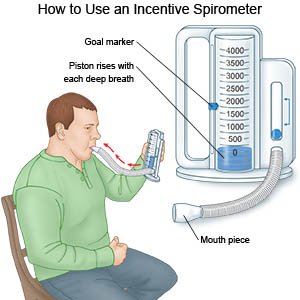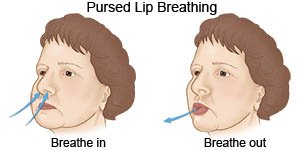COPD: Breathing Exercises
Medically reviewed by Drugs.com. Last updated on Apr 6, 2025.
AMBULATORY CARE:
Breathing exercises
may help you manage symptoms of COPD, such as shortness of breath. The exercises strengthen the muscles you use to breathe. They may also help you get air easier when you are having trouble breathing. Your healthcare provider will tell you how often to do these exercises.
Deep breathing and coughing
can decrease your risk for a lung infection:
- Take a deep breath and hold it for as long as you can. Let the air out and then cough strongly. Deep breaths help open your airway.
- You may be given an incentive spirometer to help you take deep breaths. Put the plastic piece in your mouth and take a slow, deep breath. Then let the air out and cough. Repeat these steps 10 times every hour.

Pursed-lip breathing
can be helpful before you start an activity or any time you feel short of breath:
- Breathe in through your nose. Use the muscles in your abdomen to help fill your lungs with air.
- Slowly breathe out through your mouth with your lips slightly puckered. You should make a quiet hissing sound as you breathe out.
- Try to take 2 times as long to breathe out as to breathe in. This helps you get rid of as much air from your lungs as possible.
- Repeat this exercise several times. When you are used to doing pursed-lip breathing, you can do it any time you need more air.

Diaphragmatic breathing
will help strengthen the muscles you use to breathe:
- Place one hand just below your ribs. Place your other hand in the middle of your chest over your breastbone.
- Breathe in slowly through your nose, as deeply as you can.
- Breathe out slowly through pursed lips. As you breathe out, tighten the muscles just below your ribs. Use your hand to gently push in and up while you tighten the muscles.
- Diaphragmatic breathing takes practice. Slowly increase the amount of time you spend during each practice session.
© Copyright Merative 2025 Information is for End User's use only and may not be sold, redistributed or otherwise used for commercial purposes.
The above information is an educational aid only. It is not intended as medical advice for individual conditions or treatments. Talk to your doctor, nurse or pharmacist before following any medical regimen to see if it is safe and effective for you.
Further information
Always consult your healthcare provider to ensure the information displayed on this page applies to your personal circumstances.
